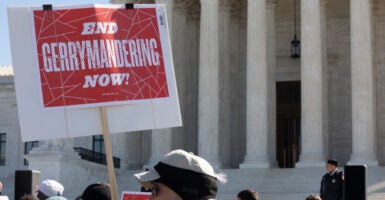In an Aug. 1 decision over redistricting of county commission seats in Galveston, Texas, the 5th Circuit U.S. Court of Appeals has issued a decision that stops the political misuse of the Voting Rights Act by Democrats and their allies to create voting districts loyal to the Democratic Party instead of protecting the voting rights of minorities. This decision may also affect the political makeup of Congress and state legislatures in Louisiana, Mississippi, and Texas—the states within the jurisdiction of the 5th Circuit—moving dozens of seats from Democrat to Republican.
In Petteway v. Galveston County, the full appeals court concluded that Section 2 of the Voting Rights Act does not protect or “authorize coalition claims, either expressly or by implication.” Coalition districts are districts in which no single minority group constitutes a majority of the voters. Instead, in those districts, there is a combination of different minority racial, ethnic, or language groups that make up a majority of voters.
The citizen population of Galveston County is 58% white, 22.5% Hispanic, and 12.5% black. Although the black population is concentrated in the center of the county, the Hispanic population is evenly dispersed throughout. The county commission consists of five seats: four elected from specific districts and one elected at-large. Neither the black nor the Hispanic population of Galveston County is large enough and concentrated enough to draw a single commission district in which either group constitutes a majority of the voters in that particular district.
As a result, in 1991, the county drew one coalition district that combined the black and Hispanic population in one district, which was represented by a black Democrat as of 2021. The other seats were all held by Republicans, including a black Republican. However, in the 2021 redistricting, the county eliminated the coalition district, which had a black citizen population of 31% and a Hispanic citizen population of 24%.
The NAACP and the Justice Department led by Attorney General Merrick Garland, along with a number of individual plaintiffs, sued Galveston claiming that this was a violation of federal law because coalition districts are required by Section 2 of the Voting Rights Act.
But the appeals court disagreed, concluding that minority coalition claims are inconsistent with the clear text of Section 2 and “Supreme Court cases rejecting similar ‘sub-majority’ vote dilution claims.”
To understand this holding, one has to look at the actual text of Section 2. It forbids the use of any voting practice or procedure that “results in a denial or abridgment of the right of any citizen … to vote on account of race or color, or in contravention of [the provisions protecting language minorities].” A violation is shown if the election process is “not equally open to participation by members of a class of citizens” defined by race, color, or inclusion in a language minority, “in that its members have less opportunity to participate in the political process and to elect representatives of their choice.”
The appeals court pointed out that Section 2 protects “‘a class’ in the singular, not the plural.” Moreover, Section 2 requires showing that the electoral process is not equally open to participation “by members of a class of citizens,” not “classes” of citizens.
Thus, Section 2 protects members of a single class of citizens, such as blacks or Hispanics, but not what are in essence political coalitions or alliances between these different racial groups. “A class,” said the court, “cannot be read to encompass two distinct minority groups.” Section 2 “makes this clear by tying the statute’s protection of voting rights to the particular race, color, or language minority status of individual citizens.”
The court noted that Section 2 says that the “extent to which members of a protected class have been elected to office … is one circumstance” which should be considered in determining whether the votes of that protected class have been diluted.
This provision “only makes sense if it is restricted to a specific racial or language-minority group.” As the court says, Hispanics in Houston would not “see citywide elected black politicians as evidence against any dilution of Hispanic voters. The election of black officials would be an irrelevant ‘circumstance’ in determining whether a state or political subdivision is diluting the strength of Hispanic voters.”
There was no reason to refer to the legislative history of the Voting Rights Act, the court stated, because “the text of Section 2 is clear.” In any event, the argument on this issue by the NAACP and DOJ, said the court, was “riddled with distortion and error.” Not a very complimentary comment on the legal competence of the Garland Justice Department.
Although the Supreme Court has not dealt with coalition districts, it has dismissed the claim that crossover districts are protected by Section 2. Crossover districts are districts in which a minority population such as black voters are combined with a minority of white voters, all Democrats, who then constitute a majority voting bloc in that district.
The appeals court pointed approvingly to the Supreme Court’s decision in Bartlett v. Strickland (2009), in which the Supreme Court held that recognizing a Section 2 claim “in this circumstance would grant minority voters ‘a right to preserve their strength for the purposes of forging an advantageous political alliance’ with voters outside the minority group.” But Section 2 does not grant “special protection to a minority group’s right to form political coalitions.” The Supreme Court’s decision in Bartlett, said the 5th Circuit, “disfavors Plaintiffs’ preferred interpretation of Section 2.”
In reaching this decision, the court overturned its own prior 1988 precedent, Campos v. City of Baytown, which recognized coalition districts. However, the appeals court said that decision was “notable for its meager reasoning and for the magnitude of its error.”
“The plaintiffs,” said the court, “have offered no persuasive justification for this court to adhere to Campos.”
The judges concluded with an admonishment that the court would:
[N]ot remain in the forefront of authorizing litigation, not compelled by law or the Supreme Court, whose principal effects are to (a) supplant legislative redistricting by elected representatives with judicial fiat; (b) encourage divisively counting citizens by race and ethnicity; and (c) displace the fundamental principle of democratic rule by the majority with balkanized interests.
There are three important things to keep in mind about this decision. First, although it involved county commission districts in Galveston, the court’s holding that coalition districts of combined black and Hispanic populations are not required by the Voting Rights Act applies to every type of political district in Louisiana, Mississippi, and Texas, from city council to congressional seats.
This could shift dozens of political seats from Democrats to Republicans. In Texas alone, according to a May story by the New York Post, which was covering the oral arguments in this case, there are “at least five coalition House districts” represented by Democrats, including “most famously, downtown Houston’s 18th Congressional District, long held by Rep. Sheila Jackson Lee,” who recently passed away.
Second, this decision stops the political misuse of the Voting Rights Act, at least in the 5th Circuit, to protect Democrat Party interests. Section 2 was intended to stop racial discrimination and vote dilution, not to protect and guarantee the success of political party alliances between different groups of voters.
Third and finally, the 5th Circuit has now joined the 6th Circuit Court of Appeals, which covers Kentucky, Michigan, Ohio, and Tennessee, which held in 1996 that Section 2 does not cover coalition districts. Perhaps the 11th Circuit, which covers Alabama, Florida, and Georgia, and which had followed the 5th Circuit’s reasoning in the Campos decision, will reconsider its own prior precedent now that the 5th Circuit has overturned Campos.
In fact, the 5th Circuit noted it is unclear whether this is the prevailing law in the 11th Circuit since that court “ultimately held against the coalition on other grounds.”
Other circuits have resolved cases involving coalition districts without “discussing or deciding whether coalition claims are permissible,” said the 5th Circuit.
Ultimately, the Supreme Court will have to decide this issue, and that will, at least in this case, depend on whether the NAACP and the Justice Department decide to appeal. Given the Supreme Court’s prior decision in the Bartlett case on crossover districts, if I were a betting man, I would bet against any appeal being filed.
Editor’s note: Galveston County was represented by the Public Interest Legal Foundation, of which the author is a board member.































